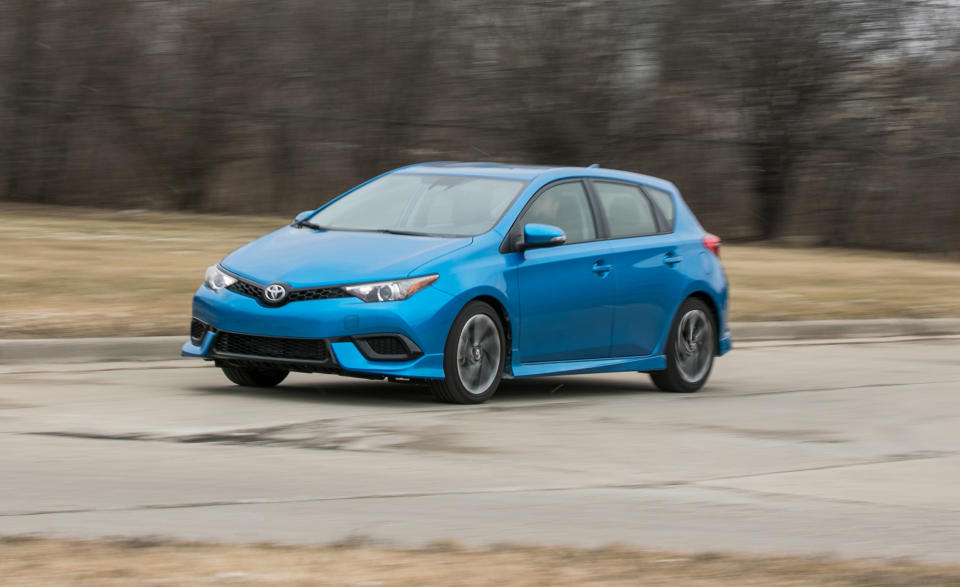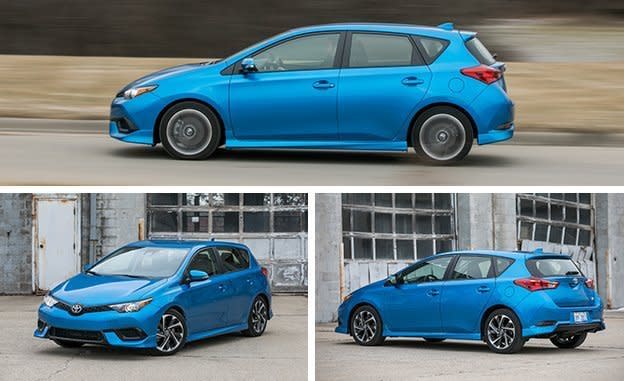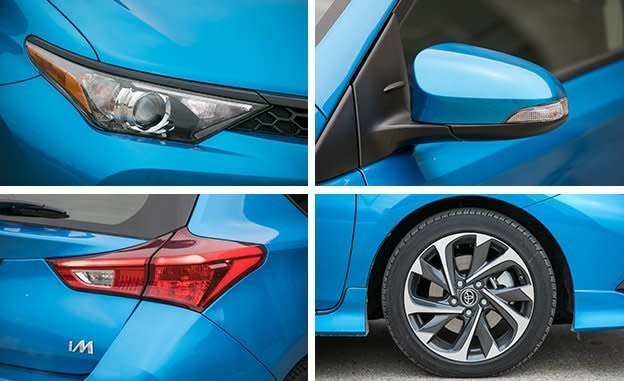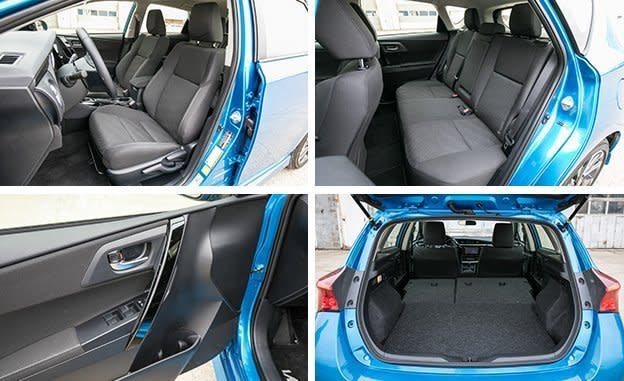2017 Toyota Corolla iM Automatic

Those paying attention will recognize this snappy-looking compact hatchback, sold overseas as the Toyota Auris, as the same car that made its U.S. debut badged as the 2016 Scion iM. Soon after the iM appeared in showrooms, the Scion brand was snuffed out, so it has been absorbed into the bosom of Mother Toyota as a 2017 Corolla variant.
It adds a strong element of cosmetic pizzazz to the Corolla line, which for decades has been limited to sedate coupes and sedans in the United States. It would be a lovely thing if that snazzy exterior were indicative of what lies beneath, but sadly it’s not. The Corolla iM only looks hot on the surface. Down deep it’s as tepid as any Corolla, motivated by the same 1.8-liter port-injected inline-four engine mated to the same continuously variable automatic transmission, and it delivers the same ho-hum results when the driver punches the go pedal.

Lukewarm Four
To be strictly accurate, the iM version of the 1.8-liter generates a little more horsepower (137 hp versus 132) and a smidge less torque (126 lb-ft versus 128) than it does in the standard sedan. Although it’s more than a foot shorter than the Corolla sedan (170.5 inches versus 183.1) and rides on a wheelbase 3.9 inches tidier than the sedan’s, the hatchback weighs more than the four-door—73 pounds more, based on our most recent sedan test, with both cars being equipped with CVTs.
Nevertheless, the iM proved a little quicker from zero to 60 mph, doing the deed in 9.1 seconds versus 9.5 for the sedan, though “quicker” doesn’t feel like quite the right word when a car takes more than nine seconds to get to the mile-a-minute mark.
It’s also hard to be positive about the CVT in its basic automatic mode. It exhibits the typical slipping-clutch/rubber-banding sensation that has long made these transmissions tedious—and which many other manufacturers have addressed with some success—and seems to amplify the engine’s languid output, generating an asthmatic wheeze as forward momentum plays catch-up with the engine. However, the iM’s CVT also includes a Sport mode with manual shifting and seven programmed ratios; this provides a much more tolerable driving experience, as well as prompt shifts and optimal acceleration. It would be even better with paddle shifters, but paddles aren’t part of the iM deal. The iM is available with a six-speed manual, which saves buyers $740 and provides quicker acceleration (8.6 seconds to 60 mph in the Scion-badged model).
Back-Road Dexterity
This lethargic acceleration is doubly lamentable, because the rest of the iM’s dynamic résumé is more in step with its appearance. The iM’s spring and damping rates are on the firm side of the scale, similar to, say, a Honda Civic hatchback or a Volkswagen Golf, with definitely more authority than the setup in the Corolla sedan. Besides more roll stiffness than the sedan offers, the iM also sports an independent rear suspension, a step up from the four-door’s humble beam axle.

Add up the foregoing, plus the electrically assisted power steering that’s quicker than many (2.6 turns lock-to-lock) and a click or two above average in terms of accuracy, and you have a compact hatch that’s surprisingly light on its feet. Grip, delivered by all-season rubber—Toyo Proxes 4 Plus, size 225/45R-17—could be better, but 0.84 g does match the skidpad performance of the standard VW Golf. The Toyos probably contribute to the mediocre 70-to-zero-mph stopping distance of 175 feet, although there’s no trace of fade in the brake system.
Pushed to its limits, the iM exhibits understeer that goes from mild to mulish, pretty much as you’d expect of a front-drive car wearing tires chosen for longevity and ride quality (which is smooth), rather than performance. But short of those limits—and leaving power out of the equation—the iM’s dynamics come close to vindicating its hot-hatch good looks.
The Inner iM
Other elements of the iM stack up well against similarly sized and priced hatchback competitors. There are some small swaths of hard black plastic inside but none where occupants are likely to touch them. The upper halves of the inner door panels are clad with cloth, the leather-wrapped steering wheel has the thick section and resilient grip we associate with sporty rides, and the front buckets are nicely bolstered, comfortable for cruising and supportive when the g loads build.
A 7.0-inch touchscreen in the center of the dashboard is a little meager in terms of finding and operating features, and a 4.2-inch color information screen tucks between the tach and the speedo. We still wonder about the weird white vinyl trim strip running across the lower dashboard, which survived the transition from Scion to Toyota branding. What was the aesthetic inspiration? Could it be Klingon?

But the black upholstery with white speckles looks classy, there’s room enough for two adults in the back seat with only minimal cooperation from those up front, and, like most hatchbacks, the iM swallows more cargo than its sedan counterpart—21 cubic feet versus 13.
Demerits: Toyota doesn’t want to get on the Apple CarPlay and Android Auto bandwagons. There is no factory access to satellite radio. And can we please have the home address of the systems engineer who programmed the lane-departure warning? We just want to let him or her know that it’s actually okay to drive within a foot of the lane edge lines. Really.

At $20,375 all in, the Corolla iM is well equipped and attractively priced in the world of compact hatchbacks. Fuel economy—31 mpg combined/28 city/36 highway, per the EPA—is respectable. We bracketed those figures with 26 mpg in all-around driving and 36 mpg on our 75-mph highway test run. Beyond that, the iM is quiet, comfortable, and surprisingly entertaining to drive on a winding back road, giving its operator an increased appreciation for the value of momentum.
You could say it’s like a prize fighter who has everything but a punch. That’s a pretty serious deficiency for a boxer. But in the world of compact hatchbacks, hot looks, good manners, and a reputation for durability may be just enough. But you really do want the manual transmission.
Specifications >
VEHICLE TYPE: front-engine, front-wheel-drive, 5-passenger, 4-door hatchback
PRICE AS TESTED: $20,375 (base price: $20,375)
ENGINE TYPE: DOHC 16-valve inline-4, aluminum block and head, port fuel injection
Displacement: 110 cu in, 1798 cc
Power: 137 hp @ 6100 rpm
Torque: 125 lb-ft @ 4000 rpm
TRANSMISSION: continuously variable automatic with manual shifting mode
DIMENSIONS:
Wheelbase: 102.4 in
Length: 170.5 in
Width: 69.3 in Height: 58.1 in
Passenger volume: 90 cu ft
Cargo volume: 21 cu ft
Curb weight: 3030 lb
C/D TEST RESULTS:
Zero to 60 mph: 9.1 sec
Zero to 100 mph: 27.9 sec
Zero to 110 mph: 38.9 sec
Rolling start, 5–60 mph: 9.4 sec
Top gear, 30–50 mph: 4.1 sec
Top gear, 50–70 mph: 5.7 sec
Standing ¼-mile: 17.2 sec @ 83 mph
Top speed (governor limited): 112 mph
Braking, 70–0 mph: 175 ft
Roadholding, 300-ft-dia skidpad: 0.84 g
FUEL ECONOMY:
EPA combined/city/highway driving: 31/28/36 mpg
C/D observed: 26 mpg
C/D observed 75-mph highway driving: 36 mpg
C/D observed highway range: 500 mi

 Yahoo Autos
Yahoo Autos 